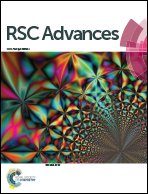One-step green synthesis of a ruthenium/graphene composite as a highly efficient catalyst†
Abstract
A simple, rapid, and green one-step synthesis was developed for an efficient catalytic composite by simultaneously reducing graphene oxide sheets and ruthenium ions in supercritical water without any external reducing and stabilizing agents. No organic solvent was involved in the entire synthesis process. X-ray diffraction, transmission electron microscopy, X-ray photoelectron spectroscopy and gas chromatography were used to characterize the hybrid material and its activities for hydrogenation of benzene and cyclohexene. The metallic ruthenium particles with an average size of 3.17 nm and narrow size distribution were uniformly anchored on the supercritical water-reduced graphene oxide (WRG). The high metal nanoparticle content (43.6 wt%) on WRG was mainly ascribed to the special role of supercritical water. The as-synthesized nanohybrid (Ru/WRG) exhibited high catalytic activities, attributable to the fine dispersion of the Ru nanoparticles and their intimate interfacial contact with the carbon support. The Ru/WRG composite was reused five times for hydrogenation of cyclohexene without detectable loss of activity, a result of its stable structure. In principle, this supercritical method is extendable to support other metal particles to fabricate highly efficient catalysts.


 Please wait while we load your content...
Please wait while we load your content...